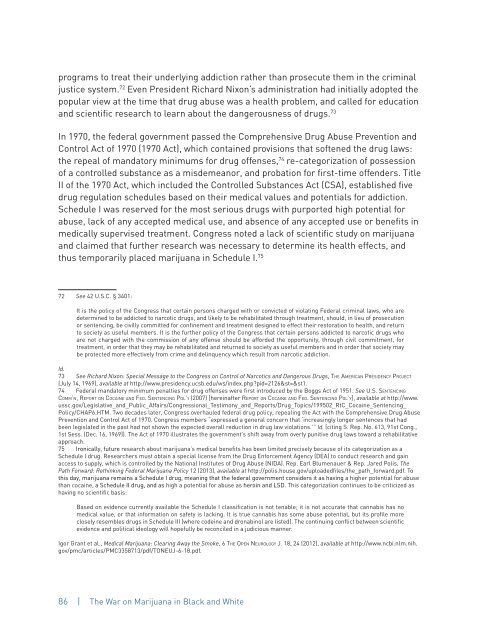tHe War on MariJUana in BlacK anD WHite
tHe War on MariJUana in BlacK anD WHite
tHe War on MariJUana in BlacK anD WHite
Create successful ePaper yourself
Turn your PDF publications into a flip-book with our unique Google optimized e-Paper software.
programs to treat their underly<strong>in</strong>g addicti<strong>on</strong> rather than prosecute them <strong>in</strong> the crim<strong>in</strong>al<br />
justice system. 72 Even President Richard Nix<strong>on</strong>’s adm<strong>in</strong>istrati<strong>on</strong> had <strong>in</strong>itially adopted the<br />
popular view at the time that drug abuse was a health problem, and called for educati<strong>on</strong><br />
and scientific research to learn about the dangerousness of drugs. 73<br />
In 1970, the federal government passed the Comprehensive Drug Abuse Preventi<strong>on</strong> and<br />
C<strong>on</strong>trol Act of 1970 (1970 Act), which c<strong>on</strong>ta<strong>in</strong>ed provisi<strong>on</strong>s that softened the drug laws:<br />
the repeal of mandatory m<strong>in</strong>imums for drug offenses, 74 re-categorizati<strong>on</strong> of possessi<strong>on</strong><br />
of a c<strong>on</strong>trolled substance as a misdemeanor, and probati<strong>on</strong> for first-time offenders. Title<br />
II of the 1970 Act, which <strong>in</strong>cluded the C<strong>on</strong>trolled Substances Act (CSA), established five<br />
drug regulati<strong>on</strong> schedules based <strong>on</strong> their medical values and potentials for addicti<strong>on</strong>.<br />
Schedule I was reserved for the most serious drugs with purported high potential for<br />
abuse, lack of any accepted medical use, and absence of any accepted use or benefits <strong>in</strong><br />
medically supervised treatment. C<strong>on</strong>gress noted a lack of scientific study <strong>on</strong> marijuana<br />
and claimed that further research was necessary to determ<strong>in</strong>e its health effects, and<br />
thus temporarily placed marijuana <strong>in</strong> Schedule I. 75<br />
72 See 42 U.S.C. § 3401:<br />
It is the policy of the C<strong>on</strong>gress that certa<strong>in</strong> pers<strong>on</strong>s charged with or c<strong>on</strong>victed of violat<strong>in</strong>g Federal crim<strong>in</strong>al laws, who are<br />
determ<strong>in</strong>ed to be addicted to narcotic drugs, and likely to be rehabilitated through treatment, should, <strong>in</strong> lieu of prosecuti<strong>on</strong><br />
or sentenc<strong>in</strong>g, be civilly committed for c<strong>on</strong>f<strong>in</strong>ement and treatment designed to effect their restorati<strong>on</strong> to health, and return<br />
to society as useful members. It is the further policy of the C<strong>on</strong>gress that certa<strong>in</strong> pers<strong>on</strong>s addicted to narcotic drugs who<br />
are not charged with the commissi<strong>on</strong> of any offense should be afforded the opportunity, through civil commitment, for<br />
treatment, <strong>in</strong> order that they may be rehabilitated and returned to society as useful members and <strong>in</strong> order that society may<br />
be protected more effectively from crime and del<strong>in</strong>quency which result from narcotic addicti<strong>on</strong>.<br />
Id.<br />
73 See Richard Nix<strong>on</strong>: Special Message to the C<strong>on</strong>gress <strong>on</strong> C<strong>on</strong>trol of Narcotics and Dangerous Drugs, <str<strong>on</strong>g>tHe</str<strong>on</strong>g> AMericAn PresiDencY ProJect<br />
(July 14, 1969), available at http://www.presidency.ucsb.edu/ws/<strong>in</strong>dex.php?pid=2126&st=&st1.<br />
74 Federal mandatory m<strong>in</strong>imum penalties for drug offenses were first <strong>in</strong>troduced by the Boggs Act of 1951. See U.s. sentenc<strong>in</strong>g<br />
coMM’n, rePort <strong>on</strong> cocA<strong>in</strong>e AnD feD. sentenc<strong>in</strong>g Pol’Y (2007) [here<strong>in</strong>after rePort <strong>on</strong> cocA<strong>in</strong>e AnD feD. sentenc<strong>in</strong>g Pol’Y], available at http://www.<br />
ussc.gov/Legislative_and_Public_Affairs/C<strong>on</strong>gressi<strong>on</strong>al_Testim<strong>on</strong>y_and_Reports/Drug_Topics/199502_RtC_Coca<strong>in</strong>e_Sentenc<strong>in</strong>g_<br />
Policy/CHAP6.HTM. Two decades later, C<strong>on</strong>gress overhauled federal drug policy, repeal<strong>in</strong>g the Act with the Comprehensive Drug Abuse<br />
Preventi<strong>on</strong> and C<strong>on</strong>trol Act of 1970. C<strong>on</strong>gress members “expressed a general c<strong>on</strong>cern that ‘<strong>in</strong>creas<strong>in</strong>gly l<strong>on</strong>ger sentences that had<br />
been legislated <strong>in</strong> the past had not shown the expected overall reducti<strong>on</strong> <strong>in</strong> drug law violati<strong>on</strong>s.’” Id. (cit<strong>in</strong>g S. Rep. No. 613, 91st C<strong>on</strong>g.,<br />
1st Sess. (Dec. 16, 1969)). The Act of 1970 illustrates the government’s shift away from overly punitive drug laws toward a rehabilitative<br />
approach.<br />
75 Ir<strong>on</strong>ically, future research about marijuana’s medical benefits has been limited precisely because of its categorizati<strong>on</strong> as a<br />
Schedule I drug. Researchers must obta<strong>in</strong> a special license from the Drug Enforcement Agency (DEA) to c<strong>on</strong>duct research and ga<strong>in</strong><br />
access to supply, which is c<strong>on</strong>trolled by the Nati<strong>on</strong>al Institutes of Drug Abuse (NIDA). Rep. Earl Blumenauer & Rep. Jared Polis, The<br />
Path Forward: Reth<strong>in</strong>k<strong>in</strong>g Federal Marijuana Policy 12 (2013), available at http://polis.house.gov/uploadedfiles/the_path_forward.pdf. To<br />
this day, marijuana rema<strong>in</strong>s a Schedule I drug, mean<strong>in</strong>g that the federal government c<strong>on</strong>siders it as hav<strong>in</strong>g a higher potential for abuse<br />
than coca<strong>in</strong>e, a Schedule II drug, and as high a potential for abuse as hero<strong>in</strong> and LSD. This categorizati<strong>on</strong> c<strong>on</strong>t<strong>in</strong>ues to be criticized as<br />
hav<strong>in</strong>g no scientific basis:<br />
Based <strong>on</strong> evidence currently available the Schedule I classificati<strong>on</strong> is not tenable; it is not accurate that cannabis has no<br />
medical value, or that <strong>in</strong>formati<strong>on</strong> <strong>on</strong> safety is lack<strong>in</strong>g. It is true cannabis has some abuse potential, but its profile more<br />
closely resembles drugs <strong>in</strong> Schedule III (where code<strong>in</strong>e and dr<strong>on</strong>ab<strong>in</strong>ol are listed). The c<strong>on</strong>t<strong>in</strong>u<strong>in</strong>g c<strong>on</strong>flict between scientific<br />
evidence and political ideology will hopefully be rec<strong>on</strong>ciled <strong>in</strong> a judicious manner.<br />
Igor Grant et al., Medical Marijuana: Clear<strong>in</strong>g Away the Smoke, 6 <str<strong>on</strong>g>tHe</str<strong>on</strong>g> oPen neUrologY J. 18, 24 (2012), available at http://www.ncbi.nlm.nih.<br />
gov/pmc/articles/PMC3358713/pdf/TONEUJ-6-18.pdf.<br />
86 | The <str<strong>on</strong>g>War</str<strong>on</strong>g> <strong>on</strong> Marijuana <strong>in</strong> Black and White


